Primaries for Congress, Senate moved to August
by Robert Lynch; April 30, 2022
The State Supreme Court judge who one month ago rejected Democrats’ redistricting maps for Congress and the State Senate as unconstitutional ordered Friday that state primaries for those offices be delayed from late June until August 23rd. It followed Wednesday’s New York Court of Appeals decision upholding the lower court’s holding on unconstitutionality .

The New York State Board of Elections responded to Judge Patrick McAllister’s April 29th order with this advisory, posted on its website:
“The Supreme Court has ordered Congressional and State Senate elections to be held Tuesday, August 23rd, 2022. The Court is working to develop a new Political Calendar to reflect this primary date. At this time, we do not foresee the June 28th primary changing for our statewide offices, the State Assembly, Judicial Delegates and Alternates and any local offices that are scheduled to be on the primary ballot. We will continue to keep voters informed as additional information becomes available.”
Additionally, the Gannet News Service reported Friday, quoting a state Board of Elections spokesperson, that the state is asking the U.S. Justice Department to see if a federal court might need to review any change to the date of the primary.
Reports indicate that statewide primaries for Governor and local primaries for Assembly and local offices—in Tompkins County, there are none of the latter—would only be postponed until August if the State Legislature orders the delay.
While not stated directly, it’s assumed that once new Congressional and State Senate districts are drawn by the Special Master appointed by Judge McAllister, each candidate who remained interested in whatever new district he or she found himself or herself in would need to repeat the process of seeking petition signatures for placement on the ballot. Whether signature requirements for any new petitioning round might be reduced would remain a decision left for the courts, the Legislature, and/or the State Board of Elections.
In Tompkins County, currently placed in the vastly-reconfigured 22nd Congressional District and the similarly-revamped 53rd State Senatorial District, the Special Master’s line-redrawing could impact who might represent us and who might not.
For the Democratic Congressional Primary, as many as six candidates are running. Yet only two of those—Josh Riley and Vanessa Fajans-Turner—list local addresses. The others hail from Onondaga County. Were Tompkins to be sliced out of the 22nd District, the candidate field could shrink barring anyone’s decision to compete out of his or her home district.
In the Republican race in that same district, Lansing’s Mike Sigler lives within Tompkins County, but his primary opponent, Brandon Williams, lives in neighboring Cayuga County.
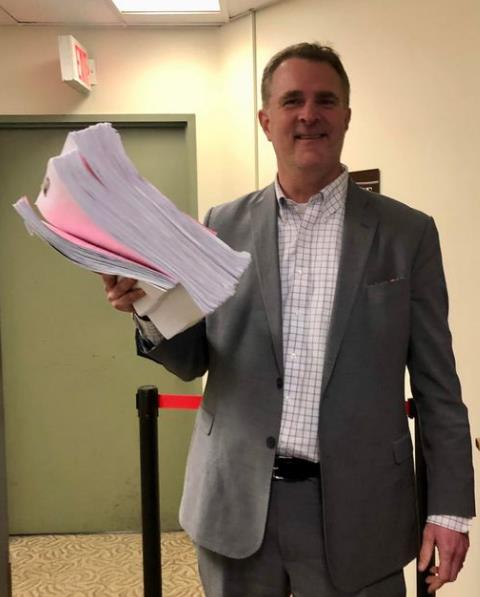
At present, two Democrats vie for State Senate in the 53rd. One of those two, Lea Webb, lives in Binghamton, at the district’s eastern fringe. Were Binghamton severed from Ithaca, Webb’s political fortunes—taking note of her sizable progressive, local support base—might change.
And should the Special Master rejoin Tompkins County with its present representational district, the sprawling Southern Tier NY-23rd, the Republican race for Congress could turn dicey. Given the presumption that Utica’s Claudia Tenney would still migrate to compete in the 23rd, the more moderate Sigler could find himself in a multi-candidate GOP free-for-all, facing Trump conservative Tenney and likely several others.
Much remains uncertain. In politics, the fall races for Congress and State Senate have suddenly become very much a jump ball.
###
Related Story; Posted Previously:
NY High Court voids Dem-drawn Congressional, State Senate Maps
In a major setback for New York’s legislative Democrats, the New York Court of Appeals, in a divided ruling late Wednesday (Apr. 27th) tossed out redistricting maps hastily drawn by the majority party last February for both the U.S. Congress and the New York State Senate.
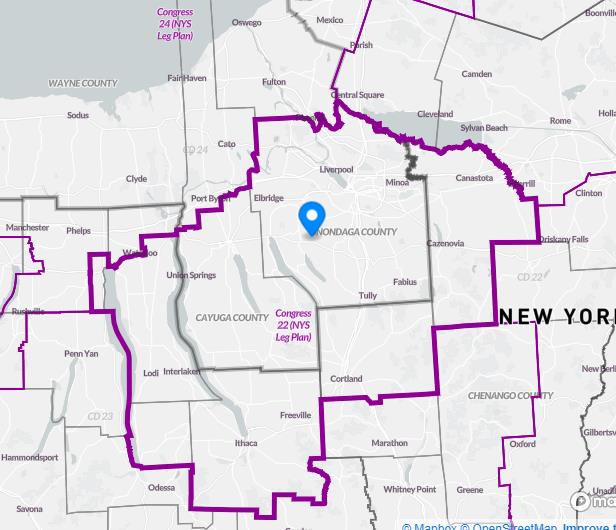
The Court’s 32-page majority opinion came stunningly fast, just one day after the Court heard oral arguments in the case.
The ruling reached further than had the opinion last week of mid-level Appellate Division judges and held closer to that of the Steuben County State Supreme Court judge who first granted the protesting Republicans’ legal challenge March 31st.
****
Among the first to report this story was Nicholas Fandos of The New York Times. His initial report, datelined Wednesday at 4:19 PM, follows, reported in relevant part:
New York’s highest court ruled on Wednesday that Democratic leaders had violated the State Constitution when they drew new congressional and State Senate districts, and ordered a court-appointed special master to draw replacement lines for this year’s critical midterm elections instead.
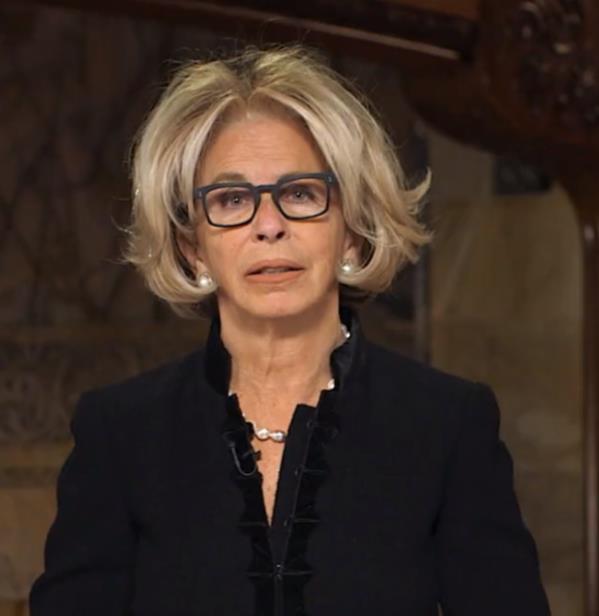
In a sweeping 32-page ruling, a divided New York State Court of Appeals chided Democrats for defying the will of voters who adopted constitutional reforms in 2014 to curb political influence in the redistricting process and create a new outside commission to guide it.
The judges additionally found that the congressional districts designed by Democrats were “drawn with impermissible partisan purpose,” violating an explicit state ban on partisan gerrymandering and undercutting the party’s national campaign to brand itself as the champion of voting rights.
“Through the 2014 amendments, the people of this state adopted substantial redistricting reforms aimed at ensuring that the starting point for redistricting legislation would be district lines proffered by a bipartisan commission following significant public participation, thereby ensuring each political party and all interested persons a voice in the composition of those lines,” Chief Judge Janet DiFiore wrote for the four-judge majority.
The verdict, which is not subject to appeal, delivered a stinging defeat to Democrats in Albany and in Washington and cast this year’s election cycle into deep uncertainty. Party leaders were hopeful that the Court of Appeals, with all seven judges appointed by Democratic governors, would overturn earlier decisions by [Steuben County Supreme Court Judge Patrick McAllister.]
Instead, the high court issued an even more damning verdict that denied the Democrat-dominated State Legislature a chance to redraw the maps itself. That task, the judges said, should be handled by a politically neutral special master overseen at the trial court level.
The court also indicated that the June 28 party primaries for the congressional and State Senate districts would likely have to be postponed until August to allow time for the new maps to be drawn and for candidates to collect petitions to qualify for the ballot….
Wednesday’s decision was a milestone in New York jurisprudence, the first time since the 1960s that the Court of Appeals has struck down district lines approved by lawmakers in their once-in-a-decade redistricting process.
[Expect more independent reporting here as the decision is analyzed. ]
###
County Commission finalizes maps for a 16-member Legislature
by Robert Lynch, April 26, 2022
The Tompkins County Legislature would grow by two members to a body of 16 under a redistricting plan recommended unanimously Tuesday (Apr. 26th) by the County’s Independent Redistricting Commission.
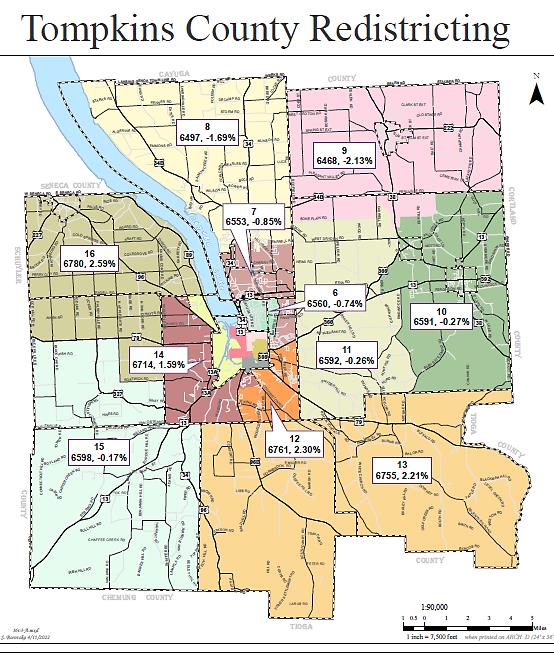
The commission’s districting maps, agreed-upon Tuesday, would also continue to split the Town of Enfield between two legislative districts, leaving Enfield divided much as it’s been for decades. The commission’s favored plan would continue using Mecklenburg Road, State Route 79, as the principal east-west dividing line separating the current District 5, now represented by Ulysses’ Anne Koreman, from District 8, now served by Newfield’s Randy Brown. However, in a departure from the status quo, that state thoroughfare would split the districts only part way from the town’s west to its east.
Enfield’s boundary changes would occur south of Route 79 and east of Applegate Road. To balance population totals to meet new, more stringent state-set standards, the commission’s plan would shift four large rural blocks from Brown’s district to Koreman’s. As now proposed, Koreman’s Ulysses-centered district would dip south from Mecklenburg Road to Bostwick Road and extend east from South Applegate Road to Sheffield Road, the town line.
“I’d like to keep the hamlet (of Enfield Center) intact as much as possible,” Enfield Councilperson Robert Lynch (this writer), the meeting’s only municipal guest speaker, told Tuesday’s meeting. “That’s where the center of our town is, where the center of government is; the Town Hall, the Community Center, the Fire Hall.”
“It all works out fairly well,” Lynch said of the commission’s preferred plan.
Lynch urged adoption of the Applegate-Bostwick Road district split rather than an alternate plan, advanced at a meeting two weeks earlier, but rejected Tuesday. That alternative would have split Enfield’s legislative districts along Enfield Center Road and through the heart of Enfield Center.
The Tompkins County Legislature retains the final say on legislature size and district composition. But in past decades its members have relied heavily upon the independent group’s recommendations. The Commission will take public comment on the maps it’s endorsed at an input session May 10th in County Legislative Chambers.
Though the Enfield Town Board had initially urged the Commission place its entire municipality within a single legislative district, ostensibly to improve the town’s influence in county governmental affairs, draft maps and representational alternatives advanced during the commission’s more than four months of meetings pointed to the commission’s inability to accommodate Enfield’s request without inflicting greater damage elsewhere.
The compromise plan endorsed Tuesday—unlike some the commission had discussed previously—would retain neighboring Newfield and Ulysses each under single-member representation. In each instance, map-makers grafted onto the Newfield and Ulysses districts as much of Enfield as it took to make the numbers balance.
Expanding the County Legislature from 14 members to 16—membership had stood at 15 until a decade ago—will not rest well with some. At a prior meeting, Dryden County legislator Mike Lane had urged the commission to cut his group’s membership down to 13, mostly for the sake of efficiency. Faced with a schedule conflict, Lane did not attend the Redistricting Commission’s Tuesday session.
But Lane’s idea never gained traction with the commission. And staff found problems drawing maps with anything but a 16-member Legislature. Other legislative sizes, the commission found, created oddly-configured districts that jumped municipal lines and violated a key commission goal of giving “communities of interest” common representation.
Another powerful force driving the commission toward a 16-member Legislature was the City of Ithaca. City leaders sought the simplicity of having five County legislative districts align with Ithaca’s five wards. With a single exception, the commission’s plan answered the City’s request. Only a small part of Ithaca’s west end between Fulton and Meadow Streets, the Route 13 “couplet,” failed to give the City those common borders. To achieve proper balance, a couple of the City-based districts would extend representation outward into the Ithaca Town.
As the commission neared its final recommendation Tuesday, Enfield stood as one of but two areas of the county where representational boundaries remained unsettled. The other area was suburban Lansing. But there only a few blocks just north of the village line received members’ attention.
For Enfield, the choice stood between grafting the Town’s eastern areas onto the Ulysses district, or else those in the west and southwest parts of the town. An alternate not chosen would have dipped the Koreman district into parts of Enfield where children attend the Odessa-Montour school system.
Though the County Legislature will likely adopt a redistricting plan later this year, the changes it makes would not take hold until the next legislative elections in November 2025.
###
Court of Appeals hears Redistricting Arguments; decision imminent
Posted April 27, 2022
The legal argument over whether New York’s newly-drawn Congressional districts were unconstitutionally gerrymandered could soon be resolved.
New York’s highest court, the Court of Appeals, heard oral arguments Tuesday (April 26th) in the Republican-brought challenge to state legislative Democrats’ map-drawing efforts. News reports indicate the Court could render its decision later this week, perhaps as soon as Wednesday.
As to Tuesday’s arguments, Nicholas Fandos of the New York Times wrote the following. Provided here are excerpts of Fandos’ report:
New York Democrats made a last-ditch appeal to the state’s highest court on Tuesday to overturn a pair of lower-court rulings and salvage newly drawn congressional districts that overwhelmingly favor their party.
In oral arguments before the New York State Court of Appeals, lawyers for the governor and top legislative leaders said that Republicans challenging the lines had fallen short of proving that the state’s new congressional map violated a state ban on gerrymandering.
But the arguments turned tense at times, especially as several members of the seven-judge panel scrutinized the constitutionality of the mapmaking process itself.
Voters created a new redistricting commission in 2014 to help wean politics from the mapmaking process, at the same time that they outlawed gerrymandering. But after the commission’s efforts broke down this winter, the Democratic-led Legislature quickly shunted aside the commission’s proposals in favor of more politically favorable maps.
“Isn’t that evidence of a purpose to gerrymander?” Judge Michael Garcia asked lawyers for the Democrats….
The Court of Appeals judges, all of whom were appointed by Democratic governors, appeared to be wrestling with how to balance the interests of the voters, the longstanding right of the Legislature to set district lines and more pragmatic questions about how and when this year’s critical midterm elections should proceed.
The court has traditionally shown deference to state lawmakers to set boundaries that they feel are appropriate. But the questions this time were particularly thorny because the case — Harkenrider v. Hochul — is the first time that the courts have tested the 2014 constitutional changes.
The challengers, New York voters backed by national Republicans, have argued that the mapmaking power should have gone directly to the courts, not the Legislature, when the commission collapsed this winter. Instead, they contend, Democrats hijacked the process and drew lines expertly devised to knock out Republicans.
The commission violated the law, the Republican lawyer, Misha Tseytlin, said, “but then the Legislature attempted to take a step that it had no legal authority to take.”
Democrats rejected both claims. They maintain that the commission was an advisory body whose maps required lawmakers’ approval to become law. And they defended their congressional map as a good-faith effort to balance competing requirements to preserve the cores of existing districts and communities of interest — which includes racial and ethnic groups — while achieving maximum compactness and adjusting for population shifts that generally benefit Democrats.
“Maybe the petitioners would have drawn the map a little differently, maybe someone from a think tank or the editorial board of a newspaper would have drawn these maps differently, or somebody on Twitter,” said Craig R. Bucki, a lawyer for State Assembly Democrats. “But the fact is they are not the Legislature, and they are not elected by the people, and that’s why all these maps should be upheld.”
[See the earlier story, posted below, for further background and context.]
###
Appellate Court tosses out Congressional maps
State Senate, Assembly maps spared for now
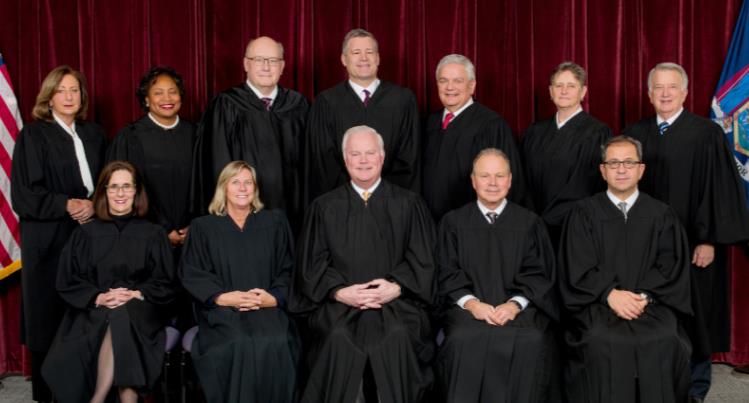
by Robert Lynch; revised and updated April 22, 2022
If New York redistricting was a three-act play, think of us as at the close of Act Two. Also consider—though it’s still a long-shot—that when all the legal and legislative dust settles, we could find our Tompkins County plunked right back into Tom Reed’s Congressional District, with Lansing’s Mike Sigler challenging Trump ally Claudia Tenney for the Republican nomination. Yes, in the opinion of many, that could be quite a show.
In a split decision Thursday (April 21st), five judges on a Rochester-based state appellate court affirmed a lower court judge’s ruling that the Congressional districts legislative Democrats redrew in a partisan show of strength this past February stand in violation of the New York Constitution. But the 3-2 decision by the Appellate Division’s Fourth Department let stand similarly-partisan maps drawn for New York’s State Senate and Assembly districts.
“[W]e agree,” said the Fourth Department’s majority, “that the congressional map was unconstitutional in that it violated [the Constitution’s command] that ‘districts shall not be drawn to discourage competition or for the purpose of favoring or disfavoring incumbents or other particular candidates or political parties.”
All expect the mid-level holding will quickly advance to its final forum, the New York Court of Appeals.

New York’s highest Court will likely expedite the case. Nevertheless, the continued proceedings could endanger holding firm to the state’s current June 28th date for Congressional primaries. Should district lines remain in risk of changing, and candidate slates reshuffled, boards of elections might lack the time to print ballots and contenders encounter obstacles in qualifying within their new territories.
The Fourth Department’s three-judge majority Thursday gave the Legislature until April 30th to “enact a constitutional replacement for the congressional map.” Majority Democrats have given no indication they’ll adhere to the deadline, or even that they’ll initiate the process. Instead, they’ll appeal the decision, which would likely stay the date for compliance.
“We are pleased that the Appellate Division confirmed what all New Yorkers know: The congressional map that the Democrats in the Legislature adopted is an egregious, unconstitutional gerrymander,” said former Hudson Valley Congressman John Faso, the GOP’s point person in this legal fight. Faso called Thursday’s ruling a “great victory.”
Democrats, meanwhile, took comfort where they could. They expressed thanks that the appellate court stopped short of throwing out State Senate and Assembly maps as well.
Mike Murphy, a spokesperson for Senate Democrats, said he was “pleased” the judges tossed aside the procedural arguments that the lower court judge, Steuben County’s Patrick McAllister, had employed to invalidate state legislative maps. Murphy also predicted the congressional maps would survive the final Court’s scrutiny.
“We always knew this case would end at the Court of Appeals and look forward to being heard on our appeal to uphold the congressional map,” Murphy told reporters.
Observers note partisan alliances could influence judicial outcomes. All seven Court of Appeals justices owe their appointments to Democratic governors. Mid-level appellate judges, by contrast, are elected within judicial districts. Of the three majority judges who ruled Thursday in Rochester, two, John Centra and John Curran, are Republicans; while the third, Stephen Lindley, is a Rochester Democrat. Both dissenters, Gerald Whalen and Joanne Winslow, were elevated to the appellate court by Governor Cuomo.
But until the Court of Appeals rules, outcomes defy prediction. Not once, but twice, have courts struck down the State Legislature’s congressional maps on grounds they’re gerrymandered. And though Tompkins County’s newly-found district, the Syracuse-dominated New York 22nd, remains fairly compact and contiguous, its Albany partisan architects drew it for a purpose—to favor Democrats.

Should bipartisan panels find themselves compelled to re-draw the lines, one can easily envision that a “quick-fix” could be to peel off Tompkins County—or at least a portion of it—and re-graft it to the Southern Tier NY-23rd, the retiring Tom Reed’s district, Tompkins County’s current representational base. NY-23 is where Republican Claudia Tenney plans to run this year. Tompkins County legislator Mike Sigler of Lansing, by most accounts, leads in his attempt to snare the Republican nomination in District 22. As many as six Democrats seek their own party’s nomination in that district.
But only should state lawmakers need to re-visit redistricting would realignments prove necessary. Judge McAllister has insisted Democrats cannot hold the drafting pen alone. Republicans must join them. If they are not allowed to, the lower court judge has warned he’ll appoint a special master to set district bounds instead.
****
Thursday’s Fourth Department ruling closely paralleled the conclusions that one of the majority jurists, Stephen Lindley, had implied when Lindley stayed Judge McAllister’s March 31st holding some two weeks earlier. Then, Judge Lindley—and now, the court’s majority—upheld Judge McAllister’s arguments of constitutional gerrymandering. But Lindley dismissed McAllister’s procedural arguments. Procedurally, Judge McAllister had maintained, the State Legislature had overstepped its constitutional bounds when it took redistricting—not only for Congress, but also for State Senate and Assembly—onto itself and away from a voter-created Independent Redistricting Commission (IRC).

Since Republican petitioners had challenged the state legislative districting only on those procedural grounds, the appellate court’s rejection of the procedural arguments took Senate and Assembly redistricting off the table.
Republican Faso has signaled his party will appeal the part of Thursday’s ruling that upheld the Legislature’s procedures. One—but only one—of the ruling judges, John Curran, writing separately Thursday, agreed with McAllister that the procedure was flawed. Yet Curran would only have thrown out the Senate maps, not those for the Assembly.
“In sum, considering the direct and circumstantial evidence offered by (Republican) petitioners in totality… we are satisfied that petitioners established beyond a reasonable doubt that the legislature acted with partisan intent in violation of article III (of the State Constitution),” the Appellate Division panel wrote in its core holding.
“We conclude that evidence of the largely one-party process used to enact the 2022 congressional map, a comparison of the 2022 congressional map to the 2012 congressional map, and the expert opinion and supporting analysis of (petitioner’s consultant) Sean P. Trende, met petitioners’ burden of establishing that the 2022 congressional map was drawn to discourage competition and favor Democrats,” wrote the majority.
Indeed, it was Trende, an expert identified as the senior elections analyst for Real Clear Politics, whose data proved most persuasive to the court’s majority.
“Trende concluded that the enacted congressional map pressed Republican voters ‘into a few Republican-leaning districts, while spreading Democratic voters as efficiently as possible,’” the majority noted.
Based on that alleged gerrymandering, the court observed, whereas 2012 redistricting yielded 19 elected Democrats and eight Republicans to Congress, after the legislature redrew the maps last winter, “there were 22 Democrat-majority and 4 Republican-majority districts,” concluded the court.
“[T]he testimony of Trende was probative,” the majority wrote. And it “confirmed the inference… that the legislature engaged in unconstitutional partisan gerrymandering when enacting the 2022 congressional map.”
Dissenters Whalen and Winslow, however, found Trende’s analysis insufficient and unconvincing.
“[T]he expert’s computer model failed to account for all the criteria the legislature was required to consider during the redistricting process,” the dissent wrote. The law not only required maps devoid of partisan bias, but also districts that protect “racial or language minority voting rights,” population equality, compactness, contiguity, and “maintained the cores of existing districts and preexisting political subdivisions, including, among other things, communities of interest.”
The dissent maintained Trende’s program only addressed some of those factors, not all. And Whalen and Winslow faulted Trende for testifying that “communities of interest are a difficult concept to nail down.” One such existing district “core,” the dissent noted, was the “Southern Tier,” presumably Congressman Reed’s 23rd District.
Those who remember the early-February redistricting face-offs that left Democrats gloating and Republicans smarting may recall that the districts crafted for State Senate and Assembly were just about as gerrymandered as those for Congress. In fact, arguably the feistiest debate occurred when Senate Republicans clamored that the maps Democrats had drawn would district them out of office.
But the lawsuit first filed in Judge McAllister’s courthouse in Bath was initially about Congress only. Petitioners enlarged their complaint only later to include the State Senate, and then, only on the process’s procedural defects. Blame imperfect lawyering for Republicans’ failure to fault the Senate cartography on substantive grounds. With a better strategy, the petitioners might have prevailed.
Why Judge McAllister’s procedural arguments failed to gain traction on appeal may find itself based on the reviewing jurists’ willingness to accord those who draft the laws the benefit of the doubt when those laws stray into constitutional no man’s land.

Only when the bipartisan IRC deadlocked and failed in its constitutional charge did the very-partisan Legislature step in, flexing muscle with a newly-minted law of its own. Though Republicans allege Democrats had choreographed the outcome, the Fourth Department gave the majority party a pass.
“We conclude that the New York Constitution is silent as to the appropriate procedure to be utilized in the event that the IRC fails to submit a second redistricting plan to the legislature as constitutionally directed,” wrote the appellate court’s majority, “and we thus conclude that the legislation used to fill the gap in the procedure is not unconstitutional and that the redistricting maps enacted by the legislature pursuant that that legislation are not void ab initio.”
As Rep. Faso has forecast, that failed procedural argument, the one challenging the Senate and Assembly maps, may live to fight another day. But for now, the focus lies with the candidates for Congress yet unchosen, and with a primary date that remains written only in pencil.
The Court of Appeals could hear the redistricting case within the week.
###
Brown stakes his ground on sales tax payouts
Posted by Robert Lynch, April 20, 2022
Freshman Tompkins County legislator Randy Brown, perhaps through bravery, or maybe a touch of naiveté, plans to venture where no member of his group has gone before. Well, at least not for the past two decades. The Newfield Republican, first elected last November, seeks to revisit the complex—and he would argue inequitable—formula Tompkins County uses to split local sales tax receipts among itself and its towns, city, and villages.
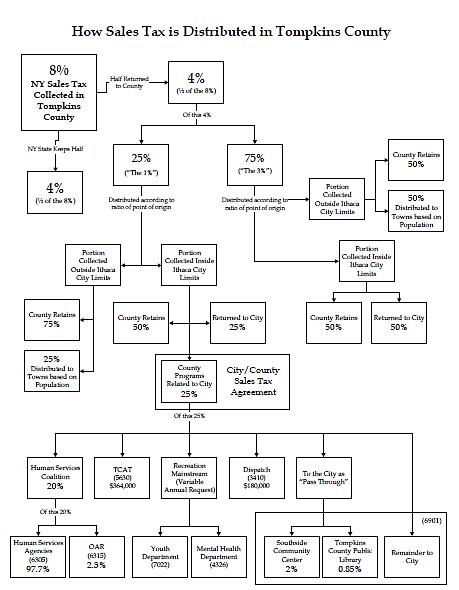
“It’s not fair,” Brown said bluntly—and privately—moments after the Tuesday evening (April 19th) Legislature meeting adjourned. In a sudden stand of principle on an otherwise-mundane budget transfer, Brown had just cast the lone dissenting vote. It stood symbolic of Brown’s objection to a long-standing and carefully-negotiated city-county compromise that’s given Ithaca, Brown would argue, too much of our community’s rapidly-growing sales tax booty, and towns like his—Enfield and Newfield—too little.
“I just feel that my constituency is being shortchanged,” Brown told the Legislature at an earlier, mid-February meeting during which the tax distribution question received more extensive discussion. At this more recent Tuesday session, with members eager to scatter, even Brown made no comment as the funding adjustment sailed through as the meeting’s final resolution, 13 votes to 1.
Many contend any sales tax remains, itself, unfair; “regressive” they’d argue. It most impacts the people least able to pay. But Brown’s focus, instead, lies with the division of sales tax receipts between Tompkins County and its municipalities. And on that score, state law and a local compromise of two dozen years ago place the City of Ithaca as the sales tax’s lopsided beneficiary.
Tompkins County now imposes an eight percent tax on purchases. It used to impose seven. Of the total, New York State skims off four percent. So the local argument involves only the tax’s last four pennies.
Under what one might term the “old” three per cent local share of the tax, the math remains quite simple. Tompkins County takes half (1.5%) and municipalities take the other half. But state law enables a city like Ithaca to “pre-empt” sales taxes imposed by businesses within its own limits. And Ithaca avails itself of that choice opportunity. Tompkins County still gets half the money. But since a disproportionate share of county commerce happens within Ithaca, the pre-emption gives the City a fatter return.
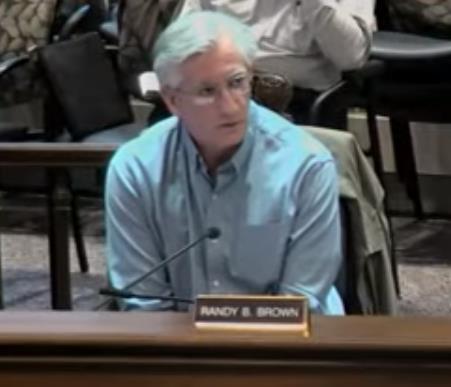
Out-of-city revenues from the 1.5 per cent left after the County takes its cut get shared based on population. Towns and villages have no opportunity to pre-empt.
That’s the easy-to-understand part of formula, the one drilled into my head as a local reporter a half-century ago. But it grew more complex, geometrically so, in 1998 when the County sought to hike the local share to four per cent. As some recall, legislators at the time grew nervous that a second City Hall pre-emption would cut too deeply into the County’s share of that extra penny.
To avoid it, City and County negotiators cut a deal, segregating the “new” tax from the “old.”
For sales outside of Ithaca, under the revised deal, County government grabs a fatter, three-quarters of the newer, one percent tax; towns and villages take just a quarter. But for in-city sales, the funding maze defies easy explanation. In simplest terms, the County takes half; the city one-quarter, and the remaining quarter gets doled out to a host of largely-City-based service agencies, ranging from the Human Services Coalition to the TCAT bus line, to the Southside Community Center.
The maze is so convoluted that a former County budget coordinator, Kevin McGuire, years ago drew a flow chart. Don’t try to memorize it.
“Frankly, as I was told, the towns and villages were sort of asleep at the switch and did not make a big issue of it back then,” Dryden’s Mike Lane, now the Legislature’s longest-tenured member, told the February 15th meeting. “But the County did negotiate in return,” Lane recalled, “that some of the money would be used for projects that were important for people in the County.”
Perhaps so. But a plan that apportions funds to the Greater Ithaca Activities Center, yet nothing to the Enfield Community Council or the Newfield Recreation Partnership leaves a sour taste in some people’s mouths, including Brown’s.
“As I look at it, it appears to me that the City is taking out more money from the sales tax than the towns,” Brown said at the February meeting. And he countered the logic of those who’d argue the City reaps more cash simply because stores locate there.
“The people in my district, they all come to Ithaca to do their shopping because there’s no place to spend their money in their town,” said Brown. “So where it’s spent doesn’t matter because they don’t have a choice.”
Those who addressed Brown’s concerns two months ago admitted the current distribution formula’s imperfections and acknowledged a potential need for change. Yet their responses also carried a touch of “best let sleeping dogs lie.”
“It (the sales tax formula) has a long history, Randy,” Lane recalled. “But I don’t think any of us has really wanted to reopen those negotiations.”
Rich John, who represents Ithaca City constituents, was even blunter.
“I think there’s great room in looking at it; to argue about, ‘Is it fair?’” John conceded. “And maybe so. But I would use the metaphor of the sweater that has the loose thread. If you start pulling at it, you can unravel the whole thing.”
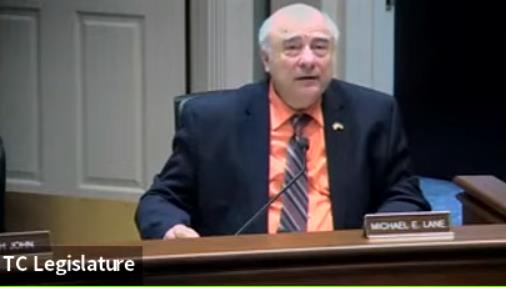
John continued, “This was a really complicated thing to put together, and I would take great care in trying to open it up and redistribute. I think that would be a very, very difficult matter to undertake.”
Difficult or not, a political hot potato or not, Brown Tuesday acted eager to revisit the distribution scheme. It may become the first issue on which the freshman legislator makes his mark. At this point, there’s no sign he’ll back down.
****
The financial resolution on which Brown dissented Tuesday underscored how well Ithaca’s commerce has weathered the pandemic. The budget adjustment reported that sales tax collections within the City had grown by more than 22 per cent between 2020 and last year, “a better result than was anticipated,” its text stated. As a result, the County needed to transfer as much as $225,000 from its sales tax coffers into the cornucopia of City-based programs covered under the 1998 agreement.
What’s more, the cash just keeps rolling in. County Finance Director Rick Snyder reported to legislators Tuesday that their county just finished a banner sales tax quarter.
It was an “astounding first quarter,” Snyder termed it. Some $10.3 Million has come in year-to-date, up 20.9 per cent over year, making January-March the best first quarter on record, he said.
But once again, the city-county divide remains. City sales tax receipts for the quarter climbed a full 29.2 per cent. Revenues assigned to outlying towns grew by just 12.4 per cent.
###
And more from the Legislature…
How do you catch a naughty hotel?
by Robert Lynch, April 20, 2022
It’s akin to the sleight of hand a cash-strapped business plays when it collects employee withholding tax but then fails to pay it to the IRS. Only Uncle Sam holds enforcement power to padlock the door. Quite obviously, Tompkins County lacks that authority, or else it prefers not to exercise it.

While Tompkins County Finance Director Rick Snyder reported to his County Legislature Tuesday (Apr. 19th) that Hotel Room Tax collections in this year’s first quarter are up a whopping 129.5% over the same period last year, Snyder also revealed that five of the county’s 30 hotels remain delinquent in paying the tax. Two of the five—both owned by the same person; Snyder did not reveal whom—owe back occupancy taxes from as far back as 2020. He said those two had only recently paid the tax for 2021.
“We are about to apply the principle of ‘Enough’ when it comes to non-payment,” the newly-appointed County Attorney, Bill Troy told the Legislature, Troy signaling a new, get-tough policy. “We will be pursuing this with some aggressiveness,” the attorney added.
“Some progress is being made,” Snyder counseled lawmakers, noting that the dual-hotel delinquent owner—historically a foot-dragger in room tax collection—has at least paid for one year out of the two. Why the owner paid for last year and not the year before, Snyder could not say. “We took the money and ran thinking something was better than nothing,” he said.
But there may be managerial strategy in play, a theory reinforced by the fact that a full 16 per cent of the county’s 30 hotels and motels stand in arrears, whereas only two of the 91 bed and breakfasts (2.2%) haven’t paid. Smaller operators, like the average taxpayer, may run scared, fearing fine or foreclosure. Larger firms may just factor fines into their business plan. (Think, for a moment, of a former President.)
“The fine or the penalty for not payment of this, it’s the cheapest financing a hotel company can get,” observed Dryden legislator Greg Mezey. “From a business standpoint, it made a lot of sense for that payment to be delayed.”
Mezey suggested County government raise the penalty for late-payments. The fine currently lists on the County’s website at ten per cent of the unpaid tax plus 1.5 per cent monthly interest. A legislative committee may look into possibly raising the penalty.
But at least one legislator urged magnanimity.
“In the pandemic, our hotel businesses in our county were probably some of the hardest hit businesses,” said Ithaca’s Rich John. “The floor dropped out from under them. It’s pretty understandable that they got well behind. They were struggling to survive through this crisis.”
Yet room tax, like employee withholding, is a pass-through tax. The hotel patron pays the tax. If no one stays at the hotel, there’s no tax to pay.

“These are trust funds,” said Budget Committee Chair Deborah Dawson. “They belong to the County from the moment they’re collected.”
Room tax, said legislator Mike Lane, “is paid by whoever rents the room, and should be properly segregated from the funds that are received by the hotel or bed and breakfast.” The hotel owner, Lane accurately stated, is “just a conduit.”
But still, legislator John remained sympathetic. “If our hotels all went bankrupt,” he said, “we’d be having a different problem right now. Businesses try to stay in business.”
###
Is the “Old Jail” in play? Only as a long shot
by Robert Lynch; April 14, 2022
“I heard the idea floated about the marketability of the Old Jail,” Tompkins County legislator Lee Shurtleff told his committee colleagues. “Is that really something that we would consider?”
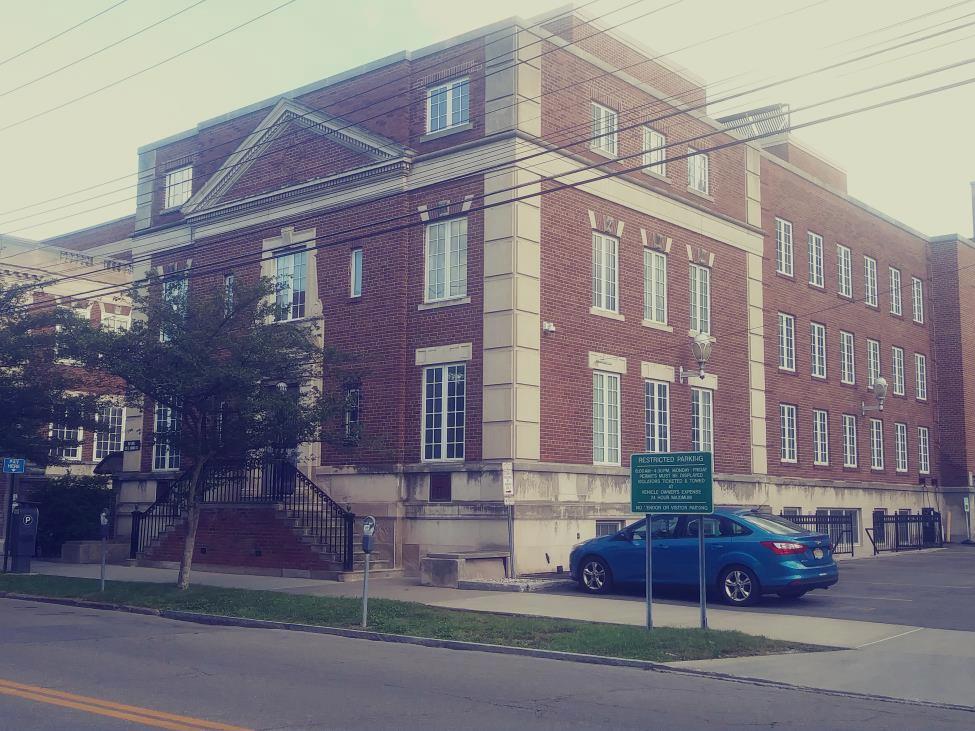
Maybe so; but probably not. Nevertheless, the historic Old Jail’s sale was a trial balloon floated—albeit briefly— during the County Legislature’s Facilities and Infrastructure committee meeting Wednesday (April 13th). The wide-ranging discussion roped-in each of the County’s downtown facilities, including a proposed big, new one: the much-sought, $30 Million downtown “Center of Government” lawmakers could build in a couple of years.
Even the Legislature’s own, recently-renovated Tompkins Building chambers got a passing glance at potential sale, though no one considered that prospect seriously.
“To me, we have functioning buildings down here,” said committee Chair Mike Lane. “Maybe we don’t need to build a giant new building. Maybe we can look at something smaller at the corner (of Tioga and Buffalo) if we keep the Old Jail and the Governor Tompkins building, both of which are historic and belong to the County.”
“If you turn them over to developers,” said Lane, “Heaven knows what happens to them at that point”
The committee for more than 90 minutes played a game of office-shuffling “musical chairs,” seeking to consolidate its government’s many departments; envisioning which among them might relocate to the Center of Government that’s likely to replace the Key Bank and Wiggins Office Buildings next to the Courthouse. For nearly two years, County Government secretly negotiated to buy those buildings, then purchased both last fall for a combined $3 Million.
County Administrator Lisa Holmes informed the legislators they must bide their time in wielding the wrecking ball. The existing buildings cannot be razed for two more years, she said, not until tenant leases at one or both of those structures expire.
The committee’s theoretical office shuffle Wednesday produced few conclusions, other than to recommend the County pay Holt Architects $10-15,000 to update a downtown facilities space study, last visited in 2019. Essentially Holt would do on paper what the committee did Wednesday in the ether.
Back last summer, at a different committee meeting, former Newfield-Enfield legislator Dave McKenna opined that maybe the Old Jail should simply come down. McKenna suggested its demolition would, in his words “open that whole area up,” maybe for parking, but mostly to give a mammoth, planned Center of Government a larger footprint on which to expand outward.
McKenna’s idea never gained traction and was cast aside at the September meeting by others, legislators who doubted the Old Jail could be razed in view of its landmark status.
But the question of the building’s possible sale had not surfaced widely until the Wednesday session. Still, the Old Jail’s offloading would carry yet a different problem.
“There’s a functional reason for keeping the Old Jail,” Holmes said. “I believe that all of the utilities that originate in the Old Jail are tied to both the Courthouse and the Daniel D. Tompkins Building, that make it somewhat essential to keep for that reason.”
A former County’s lockup, vacated in the mid-1980’s, the Old Jail was renovated in following years and converted into government offices, including those for the Administrator, the County Attorney, and Finance. Presumably those offices would relocate to the Center of Government should it be built.
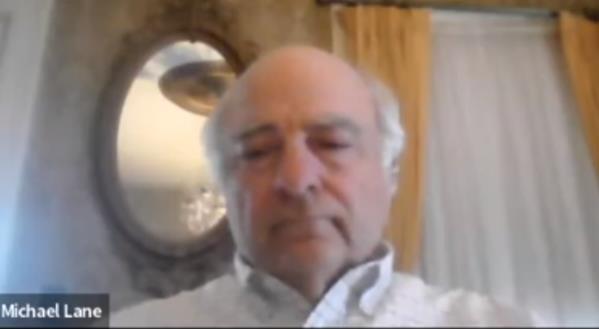
But moving the Information Technology office to any new building would pose its own connectivity problems. IT Director Greg Potter informed the committee that his compact, though tightly-wired “core data center” could not easily first move out of its current building location—likely to come down—and then into the new structure, once built.
“We cannot move temporarily and then move again into a new building,” said Potter. “We’d have to move to an entirely new location.”
The only work-around that would solve IT’s problem, should it want to make the Center of Government its new home, would be to leave standing its current quarters in so-called “Building C” until the larger building was finished. Only then would IT move and Building C could come down.
Holmes held out that option. She said some envision a “green space” where Building C now stands. It would buffer what might be a five-story Center of Government from the historic Boardman House not far from it.
But Wednesday’s session made clear that office needs—and office locations—remain very much in flux. And also far from settled is what to do with a partially-vacant lot a block away, land the County earlier purchased as its first-planned Center of Government site. The Tioga Street lot’s fate may receive attention soon, with focus on the former “dental office,” now vacant, that stands there.
Members were told that by the next committee meeting, the Facilities Director may have a cost estimate for tearing the dental office down.
###
“Enfield, we bought a salt shed.”
by Robert Lynch, Posted April 13, 2022
Debate, at times, wasn’t pretty. But by the end of a more than three-hour meeting Wednesday (April 13th), the Enfield Town Board did what all members knew needed to be done. By a series of unanimous votes, the Board authorized the Supervisor to sign a nearly $700,000 contract to construct a long-planned salt and sand storage barn behind the Town’s Highway Department garage. It also passed a Resolution to bond the expense.

The board followed through on an initial decision made at a March 22nd special meeting when it accepted the bid of ParkLane Construction of Clyde, NY for the wooden, “hi-arch gambrel” structure. ParkLane was the only firm that offered to build the type of wood-frame, side-entrance building the Town Board and its Highway Superintendent wanted. Though the company initially bid slightly higher, the final negotiated price from the firm was just over $688,000. Because electrical work and paving the building’s floor weren’t included in the ParkLane bid, the Board agreed Wednesday to bond up to $750,000 for the project.
Supervisor Stephanie Redmond will sign the contract as soon as the Town’s counsel finalizes it. Councilperson Jude Lemke, an attorney herself, advised her fellow Board members that Wednesday’s bonding action takes only the first of several steps toward debt financing. Should they choose, Enfield voters could petition to take the financing to a referendum.
The salt storage building—which the Board and Highway Superintendent Barry “Buddy” Rollins agreed Wednesday would be medium blue with a brick-red metal roof, not the same color as the tan Highway Barn—will find half its funding supported by a state environmental grant. But as the grant is apparently not paid up-front, the Town will need to finance the entire cost.
Neither construction of the salt barn, its cost, nor the Board’s intended financing has generated significant concern or opposition in Enfield to date.
Though the Board remained unified in its objective Wednesday, the process toward that decision went anything but smoothly. Multiple times before Wednesday’s meeting and several times during it, Councilperson Robert Lynch (this writer) urged for at least a one-week delay, Lynch wanting either the Town’s attorney, Guy Krogh, or the contracted bonding firm’s counsel to be present to answer questions when the Board voted. Supervisor Redmond countered that a real-time legal presence was unneeded and would just waste money. Lynch asserted he felt “uncomfortable” taking action without a lawyer by the Board’s side.
Lynch also bluntly took aim at numerous errors in the bonding lawyer’s initial submissions, mistakes he said required repeated revision in recent days, and then only in response his own review. Lynch noted that counsel had first listed the Town’s attorney by the name of the lawyer who represents Enfield, Connecticut, and had included an attachment that discussed planned demolition of a highway garage along some “Route 8” in a community unknown.

Lynch asserted that based on those flagrant errors, he’d lost confidence in the bond counsel’s competence. The Councilperson nonetheless voted to proceed with the financing measures, remarking he didn’t want to become “the skunk at the picnic.”
“We bought a salt barn tonight,” Lynch said to close Wednesday’s meeting. “It’s good for the environment, it’s good for the Highway Department, and it’s good for the Town.”
Construction of the salt shed is expected this summer.
###
Kicking the can. Tipping the hand.
Judge’s interim ruling signals hope for Dems’ Senate, Assembly Maps
Analysis by Robert Lynch, April 9, 2022

It’s early. So placing too much weight on a mid-level judge’s stopgap decision carries great risk. Judicial minds can change. Higher courts can overrule. Nonetheless, please read a Rochester appellate judge’s Friday (Apr. 8) ruling between the lines. It suggests local State Senate candidates, and also Assemblymember Anna Kelles, have less to worry about. They’re less likely to lose the districts they’d planned to run in than may candidates in the crowded race for Congress. But it will be several more weeks—more likely several months—before anyone will know for sure.
The reason behind the perceived distinction lies in matters of law and how courts have chosen to view the constitutional deficiencies in the maps Democrat-dominated state lawmakers adopted in early February. And because of that distinction, the maps for Congress, as opposed to those for the Legislature itself, stand more likely to be thrown out by the courts.

In taking action that gave everyone a moment to exhale, and also, for now, kept the pre-Primary political calendar intact, Appellate Division, Fourth Department Judge Stephen Lindley Friday granted a partial stay of a lower court’s decision that had held as unconstitutional the State Legislature’s partisan redistricting of New York’s Congressional districts and also districts for State Senate and Assembly. In many ways, he kicked the can down the road.
Had Judge Lindley not acted, legislators would have needed to draft and submit new districting maps as soon as Monday, April 11th. They’d also have been required to have both Democrats and Republicans give input and grant approval. And had they not done so, that lower judge, the State Supreme Court’s Patrick McAllister, could have named a neutral expert—a “Special Master” as one is called—to draft alternative maps and do so at State expense.
Judge Lindley’s Friday action still enables Judge McAllister to appoint the Special Master. But any map the “neutral expert” might draw drew would carry zero weight unless a higher court invalidated the maps now on the table.
“Of course,” Judge Lindley wrote, “any map drafted by such neutral expert would have no force or effect unless and until the Court of Appeals affirms Judge McAllister’s order, and the Legislature, pursuant to the redistricting legislation, is provided with 30 days from the entry of the order, to ‘discharge its constitutional mandate’ of enacting a Congressional map that does not run afoul of the anti-gerrymandering provisions of… the New York Constitution.”
Many observers, including reporters covering the story, saw Judge Lindley’s action as a victory for Democrats. The Governor and majority lawmakers had asked for the stay. And had Lindley allowed the lower judge’s fast-paced order to remain in effect, state lawmakers, now mired in past-deadline budget deliberations and reluctant to alter their February maps in any event, would have found it next to impossible to escape map-drawing by someone they couldn’t control.
But Republicans celebrated the moment as well. “Ultimately the Court of Appeals will decide, but we’re very much encouraged by this decision today,” said John Faso, the former Congressman who serves as the spokesperson for Republican petitioners.

As Faso indicated, Judge Lindley’s Friday action remains far from the final word. With Judge McAllister’s April 11th deadline no longer in full force, parties will next appear before Judge Lindley’s Fourth Department appellate court April 20th. The stay would lift only after the Fourth Department rules on the merits of the case. Still, all expect the final decision will rest with the State’s highest Court, the Court of Appeals. Successive deliberations, even if expedited, could consume months. And doubt remains whether New York’s party Primaries will adhere to their original June 28th date. Quite likely, they’d spill into August.
Nevertheless, for now, candidates and boards of elections can proceed with bureaucratic blinders on, acting like nothing around them has changed.
“The stay will, among other things, allow candidates for Congress, State Senate and Assembly to file designating petitions by the statutory deadline, and allow the boards of elections to accept such petitions,” Judge Lindley wrote. Challengers can object to petitions, elections boards can rule on them, and those dissatisfied can go to court.
“None of those actions would be permitted under Judge McAllister’s order in the absence of a stay.” Lindley pointed out. The paralysis would have gripped candidates and their overseers all because Judge McAllister had ordered the Legislature’s district maps to be stricken “from the books.” Should the maps have been voided, candidates would have had no districts in which to run, and the whole process would have ground to a halt.
What’s been written so far is what’s fixated the media. But it’s a key, prescient paragraph in the decision that most intrigues this writer, one that could signal how Judge Lindley’s court—and perhaps courts that follow—would compartmentalize the constitutional arguments that underpin this suit. And if other judges follow the same reasoning, the State Senate and Assembly districts legislative Democrats drew, albeit controversially, could be left standing, no matter how irregular their lines, no matter how partisan their genesis. Instead, courts could aim their firepower at the 26 districts Democrats drew for Congress. And Judge Lindley tips his hand in that one paragraph to the reason why they would.
We must wander into the weeds maybe a bit too much for some of those reading without a J.D. after their name. But let it be said that when the 14 petitioning plaintiffs took their challenge to Bath and into Judge McAllister’s courtroom in February, they raised two legal arguments; one procedural, the other substantive. They founded each in the State Constitution.
When Steuben County’s Tim Harkenrider and his thirteen allies brought their case to judge McAllister, they’d asserted in part that legislative Democrats circumvented the command embodied in a 2014 constitutional amendment. That amendment called for a newly-formed Independent Redistricting Commission (IRC), not the Legislature, to draw congressional and legislative lines. Late last year the evenly-divided, bipartisan IRC deadlocked and thus failed in its task.
Republicans, most notably State Senator Tom O’Mara, alleged Democrats engineered the impasse. They said majority Democrats, armed with new power and a new law they’d pushed through, wanted to take over the task the IRC did not complete. Democrats did just that. The majority flexed its legislative power to adopt Democrat-favoring Congressional maps on one February day; similarly-slanted maps for Senate and Assembly the next. Republicans cried foul.
“This was pre-ordained to fail,” O’Mara famously said on the floor of the Senate February 2nd just as Democrats put their Congressional maps to a party-line vote. Willing circumvention of the IRC’s constitutional authority lies at the core of the petitioner’s procedural complaint. It’s applies equally to congressional maps and to those for the Legislature

Judge McAllister accepted the petitioners’ reasoning. He noted that voters last November rejected a new constitutional amendment that would have enabled legislators to perform the same oversight that lawmakers chose just weeks later to take upon themselves through statute.
Judge McAllister wrote, “This court finds that the November 2021 legislation which purported to authorize the legislature to act in the event the IRC failed to act was not a mere enactment of legislation to help clarify or implement the Constitution, but in fact substantially altered the Constitution.”
“Alteration of the Constitution can only be done by constitutional amendment,” McAllister continued, “and as recently as November 2021, the people rejected the constitutional amendment that would have granted the legislature such authority.”
Initially, the “Harkenrider 14,” as we might call them, had only contested the Congressional maps. They then quietly amended their complaint to include the State Senate maps as well. Indeed, it was Judge McAllister, himself, who dragged the Assembly maps into the wastebasket. As the judge saw it, if procedural defects made the Congressional and Senate maps infirm, the Assembly maps must go as well as they were all crafted the same way.
By contrast, the substantive arguments presented the court relate to the shape and composition of the maps drawn; essentially, their “gerrymandered” nature. How compact are they? How contiguous are they? How much do they preserve the “cores of prior districts?” And most important, how much were they engineered to favor one political party over another? How much were partisan populations “packed” and “cracked,” to use common redistricting terminology.
Judge McAllister found that beyond a reasonable doubt “the congressional map was unconstitutionally drawn with political bias.” Important on appeal, McAllister could not find a similar deficiency in the State Senate maps. The judge was not asked to perform, nor did he perform, similar analysis on the Assembly maps.
The appeals court took note of that distinction. “[R]espondents (that is, the State) correctly point out that petitioners (the Republicans) never contended that the Assembly districts were unconstitutionally gerrymandered,” Judge Lindley wrote in an instructive sixth paragraph of his three-page decision granting Friday’s limited stay.
“Judge McAllister struck down the Assembly and Senate maps solely on grounds that the Legislature, in enacting the maps, failed to comply with the procedural structure… of the State Constitution,” Lindley stated.
Judge Lindley continued. “Inasmuch as it appears on the surface that petitioners may be more likely to prevail, if they are to prevail at all, on their substantive challenges to the redistricting legislation than they are on their procedural challenges, there would seem to be less need for the neutral expert, if appointed by Judge McAllister pending appeal, to draft proposed maps for Assembly and Senate districts,” (emphasis added).
Should Judge Lindley’s distinction hold as this case winds its way through the Fourth Department—and later, expectedly, the Court of Appeals— it would mean the Senate and Assembly district lines the Democrats drew would not change, that is, if the final decisions turn exclusively on substance and not procedure. They were lines that so infuriated Senate Republicans on their day of their adoption. It may not matter.
And strictly read to its letter, the text of Judge Lindley’s Friday Decision would empower Judge McAllister’s Special Master only to draw maps for Congress, not the State Legislature.
“The Legislature may begin drawing the map right now if it chooses to do so,” Judge Lindley wrote. “Or the Legislature may choose to do nothing and risk the possibility of having to live with the map drawn by Judge McAllister’s neutral expert should respondents lose before the Court of Appeals and lack sufficient time to propose a substitute map that withstands constitutional scrutiny after exhaustion of appellate remedies.”
Senate Deputy Majority Leader Michael Gianaris, who jousted with Senator O’Mara in their gentlemanly, yet intensely combative 40-minute debate over the Congressional maps February 2nd, has already made clear he has no plans to prod his chamber’s cartographers to return to work.
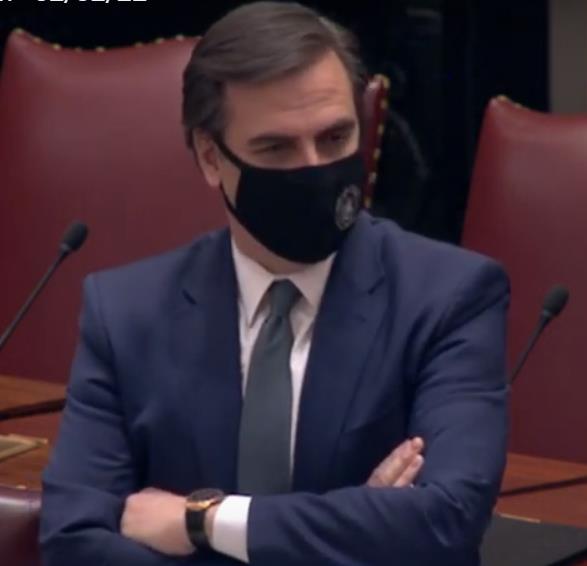
“We are confident that we’ve drawn maps that will withstand scrutiny,” Gianaris, the Senate majority’s point-person on redistricting, told an Albany-based cable news program April 5th.
Legislators redraw maps once per decade to adjust district lines to reflect population shifts within New York—and this time also to cut New York’s Congressional delegation down by one. The currently-adopted maps would, if upheld, partner Tompkins County with many new bedfellows. Tompkins County’s congressional district would newly bond with Syracuse, and sever ties with the Southern Tier. And for the first time in decades, a single State senator would serve the entire county, in a district firmly anchored to Binghamton and its western suburbs.
Meanwhile, lines drawn for the 125th Assembly District, Democrat Anna Kelles’ home base, would remain unchanged from those of the past decade.
Democrats Lea Webb and Leslie Danks Burke, and Republican Rich David seek to represent Tompkins County in the newly-drawn 53rd Senate District. Should Judge Lindley’s observation hold and find acceptance with others on the bench, those three local Senate aspirants could have the most to gain. They’ve petitioned. They’re campaigning. And were one to be cut from the district and placed somewhere else, the candidate would either be left without a constituency or forced quickly to retool.
Relax for the moment; but only the moment. Much remains for courts to decide. The next court date lies less than two weeks from the last. Everything may change again.
###
Enfield Planners: Stretch Code savings may be a stretch in themselves
by Robert Lynch, April 6, 2022
Enfield Planning Board members made clear Wednesday (Apr. 6th) they won’t take the State’s predictions of savings from a new, tougher energy code on mere face value. While they held out the possibility they’d eventually embrace the proposed “New York Stretch” code they’ve been pressed to endorse, they’ll only do so after careful thought and weighing its benefits against the costs.
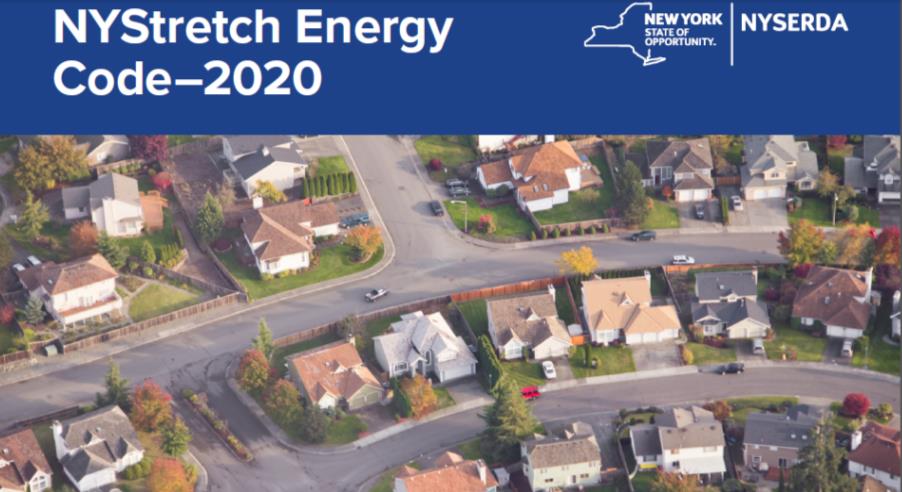
“What Allen’s talking about is not going to save 25 per cent on energy,” Planning Board member Mike Carpenter quickly asserted after Codes Officer Alan Teeter quoted State documents that claimed the Stretch Code’s better windows and shorter water pipes could cut residential energy use by nearly a quarter.
“It’s usually a best-case scenario,” Carpenter, a builder and solar installer, said of the code’s lofty predictions.
Other well-known elements of the Stretch code, frequently cited by libertarian critics as signs of overreach, include beefier breaker panels and conduits to attics to accommodate someday (maybe) solar panels, and the laying of conduits down driveways for someday (maybe) electric cars.
The Newfield Town Board, without much controversy but with its lone Republican in dissent, rolled Stretch into its building standards last August. The Enfield Town Board, has given only glancing attention to the tighter code since Stretch was first presented it two years ago. Now Supervisor Stephanie Redmond wants to hasten approval, perhaps by this June, so she can tap $5-10,000 in time-sensitive State moneys, grants the Town could use on other energy-saving projects.
Redmond pressed the Planning Board to add Stretch Code to its monthly agenda only moments before Wednesday’s meeting convened. But Board members answered by making clear they’d be no rubber stamp. They gave Stretch only a quick, but still skeptical, overview. They’ll revisit the proposed code next month, but only after doing their homework. Redmond asked Board Chair Dan Walker to apprise her of any informal member sentiment before then, so she could prep for a hoped-for hand-off to the Town Board in May.
“I wouldn’t want to make a statement off the top that it (Stretch) is going to be fine,” Carpenter cautioned. “We have to be fair to the people that are building,” he added.
When the Enfield Town Board was first briefed on the code in June 2020, a consultant projected Stretch might add only $1,500 to $2,000 to the average new home’s cost. But since then, building prices have skyrocketed. Nobody hazarded a guess Wednesday as to what Stretch compliance might cost now.
“Improving the energy code is fine as long as it’s realistic,” Walker remarked.
“I’m not really thrilled with it,” Planning Board member Henry Hansteen interjected. “I don’t see where it’s going to save a lot of energy.”
New York has made the Stretch Code an optional building standard for now. Some predict regulators will elevate it to a mandate in a year or two. But the sudden haste driving Enfield’s consideration for the moment is that eagerly-sought grant money. At least one participant at Wednesday’s meeting doubted the funding rewards were worth the burden to those who want to build.
“The trouble I have with a code, said Carpenter, “is that those who provide the input are those who manufacture the materials.” And he recalled how many communities long banned PVC pipe—he claimed some still do—because cast iron lines to the septic tank kept union plumbers employed.
****
But before they tackled Stretch, the Planning Board gave quick, unanimous consent to the proposed 60-by-168 foot wooden salt barn the Town Board plans to build where the sand piles now sit back of the Town’s Highway Garage. Even though it’s a municipal project, the building’s size—over 10,000 square feet—demanded site plan review.
A Public Hearing could have been called. But Walker said the law does not mandate it, and members saw no need for it.
“It’s a big pole barn,” Walker observed. And since it’s in the Department’s existing staging area, he said, “I’m not too concerned about the public being concerned.”
Funded, in part, by a State grant, the $700,000 salt barn will likely go up this summer.
Meanwhile, an issue that occupied two prior Planning Board meetings may suddenly have hit a dead-end. Though the Planning Board convened a Public Hearing on member Carpenter’s own plan to sell a landlocked parcel off Bostwick Road to site a new home, the member chose to pull his own subdivision plan before the hearing had ended. Carpenter said he’d concluded it would cost him more to upgrade the private road to the site than he’d earn from selling the lot.
###
Single-Payer polemics split Tompkins pols by party
by Robert Lynch; April 5, 2022
“I always like to see a Sigler-Dawson feud every once in a while,” Chair Shawna Black remarked cheerfully—though perhaps not completely truthfully—as two Tompkins County legislators, who Tuesday night shared little in common other than their home base of Lansing, battled over the wisdom, or the futility, of the New York Health Act, the Empire State’s single-payer health care bill.
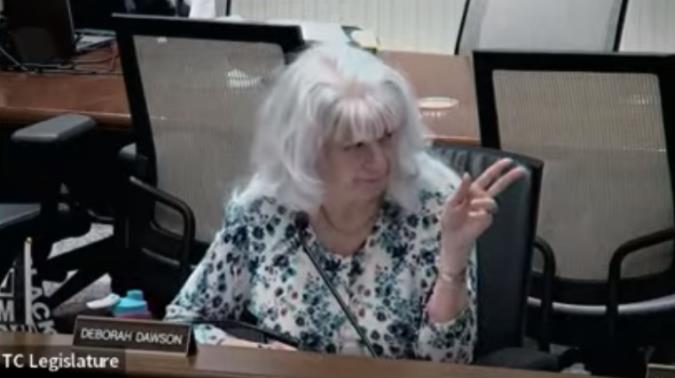
After what marked perhaps the most edgy and caustically partisan exchanges between any two of the County Legislature’s lawmakers in years, Republican Mike Sigler and Democrat Deborah Dawson each cast their votes— and everyone else did too; straight down party lines, ten votes to three —as the Legislature Tuesday (Apr. 5th) endorsed Albany’s long-stalled proposal to bring to the state universal health care. (Democrat Amanda Champion was excused from the meeting.)
In a lead-up to the final endorsement, debate on an amendment where most of Tuesday’s fireworks took place, Sigler failed to trade-in a committee-sponsored single-payer measure for a substitute Resolution he’d written, one that would have proposed instead that $11 Billion be set aside in the State Budget to fully-fund all cancer treatments.
“I want to congratulate you, Mike, you triggered me,” Dawson fired off to her cross-party colleague down the table. At that point, she launched into what she’d later admit was a rant:
“This notion that we should pay for cancer as an alternative to universal coverage is a strategy that opponents to universal health care have traditionally offered,” Dawson alleged.
Then came the snark. “We know you’re hungry. We know you need a meal. Have an appetizer and go away,” Dawson said, likely alluding to Republican Sigler’s current campaign for Congress.
Dawson may have brought her sharp tongue to Tuesday’s fight, but Sigler brought the prop; one that was round and red and right for the moment.
“It’s a big apple,” Sigler responded, analogizing health funding’s daunting challenges to the ripe fruit he held in his hand. “You can’t eat the whole apple,” he insisted. “Legislators have been looking at this for 30 years and they’re going, ‘It’s a big apple. You’re not going to be able to eat the whole thing.’ So my suggestion to you (Dawson) would be to take a bite of the apple.”
That bite, to Sigler, meant endorsing his more modest $11 Billion fight against cancer.
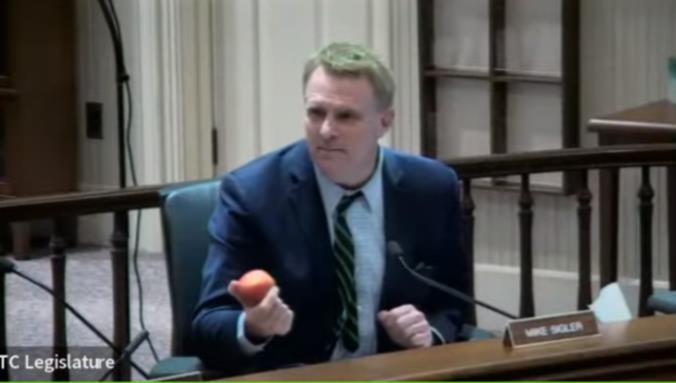
Dawson wasn’t biting. And neither were her fellow Democrats. In fact, Sigler’s amendment failed with only him voting for it. Later offering his cancer initiative as a stand-alone Resolution, Sigler saw his idea shunted to committee, where it’ll either be pondered and retooled, or else allowed quietly to die.
The Dawson-Sigler face-off served as the zestiest spice to what otherwise stood as a ponderous, nearly four-hour legislative session dealing with everything from a deep-dive PowerPoint explanation of rapidly rising property assessments to the revelation that Ithaca may soon seek to cut the speed limit on most city streets to 25 miles an hour.
And after the marathon meeting took its final turn, with legislators readying for a closed-door talk on contracts and litigation, Sigler and Dawson were still going at it, viewed from across the room raising their voices and pointing fingers.
Actually, Tuesday’s debate played out its first act nearly one year ago. Last May, the County Legislature passed a similar endorsement of the New York Health Act, and likewise had beaten back Sigler’s Resolution seeking state funds to underwrite cancer care. Back then, a couple of activists attended the (then-virtual) meeting to lobby for the majority’s Resolution. Tuesday night, no one from the public spoke in favor or against it.
During debate, legislature Chair Black Tuesday criticized the Sigler amendment. She called it “definitely a distraction from offering health care for all.”
“This was the first time my family has ever had really good insurance,” Black said of her past four-plus years on the Legislature with its government-paid health plan. And Black related how she once agonized when her then-12 year old daughter had to be treated at a pricey, high-end hospital for what turned out to be a benign tumor.
“For me as a parent,” Black said, “one of the most devastating things was actually trying to figure out how the Hell I‘m going to pay for Memorial Sloan Kettering.”
But while Black often found herself Tuesday herding the cats that populated legislative chambers, Sigler and Dawson became the two in the room most prone to scrap.
Portending her own declining years, the just-past-retirement-age Dawson said life without the assurance of universal health care is one of uncertainty and dread.
“What options do I have without some kind of insurance coverage,” asked Dawson, coverage “that assures me that I’m not going to end up on a filthy mattress in a cheap apartment somewhere with no help? You know, my teeth are rotting in my mouth and God knows what else is going; deaf, I’m blind, who knows?”
Dawson praised Medicare as efficient, operating with far less administrative overhead than does the private insurance industry she’d like the New York Health Act to replace. But Sigler turned the argument around.
“You’re bringing up all this imagery about people living on filthy mattresses,” said Sigler. ” I thought that was part of the beauty of Medicare? But you say that doesn’t happen. So which is it?”
“I’ve had five years of experience on Medicare,” Dawson angrily shot back . “You haven’t.”
“True,” Sigler conceded.
Member Mike Lane moved for the debate to end. Black attempted to pick up the pieces and herded the membership toward a vote.
Nothing guarantees Tuesday’s debate will mean more than chatter from one little true-blue upstate enclave. The New York Health Act has lived a very long life in legislative wings; reintroduced last year, but never reaching a floor vote in Senate or Assembly. It may not this year, either.
But Tuesday’s debate took stock of the passion some of Tompkins County’s left-of-center place on single-payer health care, and how frustrated they’ve become in its failure to gain legislative traction.
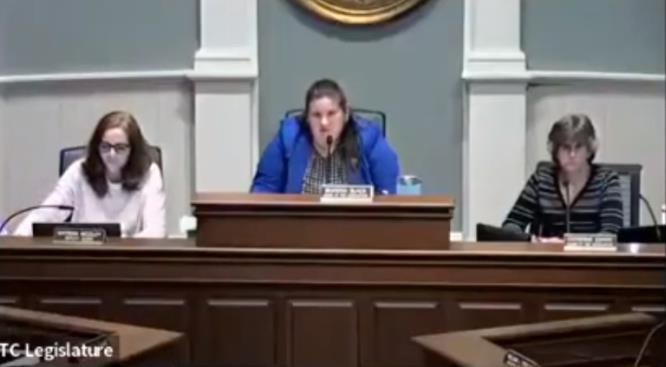
“I get that there are other diseases out there,” Sigler acknowledged to his sparring partner for the night. “I get it. That doesn’t mean that you can’t start someplace and take a bite out of the damned apple,” he said, pressing his less-costly, less-ambitious, yet more attainable cancer care measure.
“But you don’t want to do that,” Sigler accused Dawson, “Because you want the whole thing.”
“You’re not going to get the whole thing,” the Lansing Congressional aspirant continued, “because people don’t want it. They’re not voting for it… The people you’re electing to office right now aren’t voting for it.”
Dawson conceded that legislative lethargy’s a problem, with health care industry lobbying streams flowing too freely.
“I know the Democrats control both houses of the State Legislature,” Dawson acknowledged, “but they’re as greedy as the next guy.”
“Just remember that this Resolution is just to urge the State,” cautioned Black, sensing emotions running without brakes. “Whether they listen to us or not, who knows?”
###
Gerrymander’s Trashcan:
Steuben Judge throws out legislators’ redistricting plan
by Robert Lynch; Posted April 1, 2022
One thing’s for certain: For the moment at least, State Senator Tom O’Mara is one happy man. What’s far from certain, however, is knowing who might represent you and me next year in both Congress and the New York State Legislature.
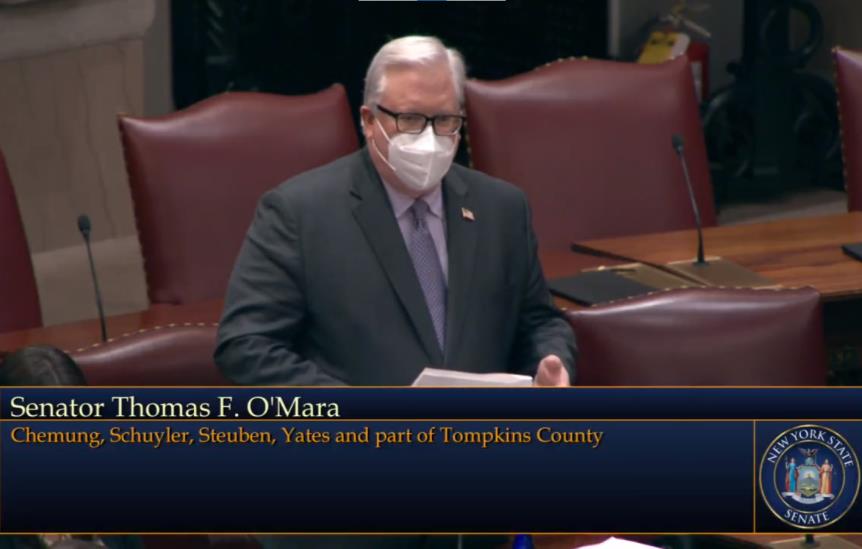
And while Democratic and Republican loyalists began this April wrapping up a month of door-to-door petitioning for their favored state and federal candidates, all the time they’ve expended, the gasoline they’ve burned and the shoe leather they’ve worn may have been for naught. They—yes, we—may have to start all over again.
In a ruling that’s overjoyed Republicans but left Democrats either smarting or crying foul, a State Supreme Court Judge in Steuben County on the final day of March declared New York’s Democratically-driven, legislatively-drawn redistricting maps for both Congress and the State Legislature as unconstitutional; gerrymandered. He ordered State lawmakers to reach across the aisle to draw new maps—and do so quickly, by April 11th.
“The court finds by clear evidence and beyond a reasonable doubt that the congressional map was unconstitutionally drawn with political bias in violation of [Article III of the State Constitution],” wrote Judge Patrick F. McAllister, a Republican whom critics allege their G.O.P. opponents forum-shopped in hopes he’d rule in their favor.
Though the case holds state-wide impact, the courthouse that petitioners selected lies ensconced in the ruby-red central Southern Tier. Judge McAllister’s Bath-based venue was picked for no particular reason other than, perhaps, that the suit’s lead plaintiff—one of 14—lives in Steuben County. Also, five of the 14 petitioners vote in the Bath judge’s same Congressional District, namely District 23, Congressman Tom Reed’s.
While faulting the Legislature’s Congressional map as unconstitutionally biased, Judge McAllister, employing a high legal standard, found no similar constitutional infirmity affecting the State Senate maps. Nonetheless, since the judge also concluded that the Legislature acted unconstitutionally when it usurped redistricting authority from an independent commission in February, he struck down the Senate maps on procedural grounds. State Assembly maps, in essence, got dragged into the trash can by being attached to everything else.
Governor Kathy Hochul was quick to react, but with few words. “We intend to appeal this decision,” Hochul posted on the executive’s website, her statement credited to both herself and Attorney General Letitia James. Hochul wrote nothing more. In early-February, Governor Hochul ratified the legislatively-drawn maps shortly after the Senate and Assembly had passed them; but then, too, without elaboration.
By late Friday afternoon (April 1st), the executive branch, the State Senate leadership, and leaders in the Assembly had filed notices of appeal. Though some observers had expected the case would go directly to the State’s highest court, the Court of Appeals, the Associated Press Friday reported that the notices were filed with the mid-level Appellate Division (the Fourth Department) in Rochester.
Whether this was a temporary way-station on route to the highest Court or a permanent point of appeal, the report failed to clarify. The notice of appeal will likely stay proceedings in the lower court.
“Legislative officials have expressed confidence that an appeals court would quickly stay the judge’s decision and ultimately rule in favor of their maps,” the AP report further stated.
Judge McAllister’s holding provides Senator O’Mara sweet vindication, The Big Flats Senator had been the GOP’s legislative point-person—and Democratic leaders’ chief foil—when State Senate Democrats on February 2nd, as did their Assembly colleagues, muscled-through a partisan Congressional redistricting plan largely along party lines. Legislators acted—Judge McAllister says illegally—after the Constitutionally-chartered Independent Redistricting Commission deadlocked, gave up attempts to compromise, and essentially failed to fulfill its duty.
As Judge McAllister left matters March 31st, State Senators and Assemblymembers must submit to his court new, bipartisan-supported maps and do so by a fast-tracked April 11th deadline. If they do not do so, or if both sides cannot agree, McAllister said, “I will retain an expert at the State’s expense to draw new maps.” The judge did not state who would serve as his “neutral expert.”
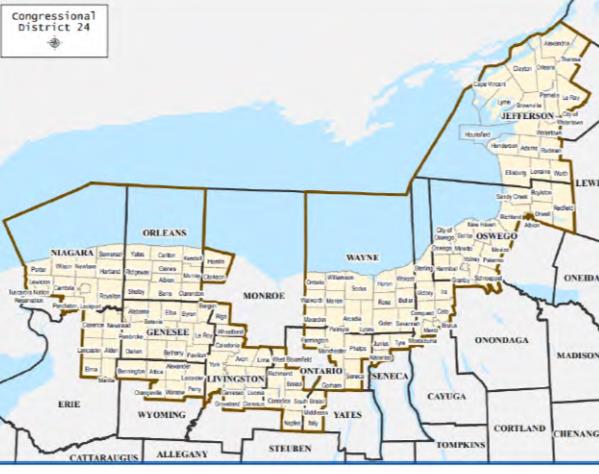
To stay the proceedings through an appeal would also draw out the judicial timeline. But any appellate action other than reversal of the lower court’s decision could upend New York’s tight, statutorily-dictated schedule for designating candidates, holding primaries, and gearing up for the November General Election.
Under New York’s election law, candidate petitioning for Senate and Assembly seats in the Legislature’s currently-sanctioned districts began March 1st. Though Boards of Elections will receive petitions through April 7th, most party volunteers have already finished their work, with their petitions handed off to their leaders for collation and submission. The State’s current schedule sets June 28th for this year’s Primary. While primaries once spilled into September, Judge McAllister Thursday warned that General Election slates must be set in time for overseas military ballots to get mailed.
“Between the primary election and that September 23rd (military ballot) date, the votes have to be counted, the elections need to be certified, candidates need time to challenge election results, and the ballots need to be prepared,” the jurist observed. “Thus, August 23, 2022 is the last possible date to hold a primary.” The judge said he’d prefer an even earlier date.
But whether or not Republican challengers prevail, the judicial process’s slow grind leads one to the inevitable conclusion: that party contests won’t be settled until late-summer and that pre-primary campaigning will stretch out for an extra two, exhausting months.
But what about the candidates themselves and the validity of those petitions they’ve already circulated?
With district lines in limbo, a candidate cannot with certainty know whether he or she lives within his or her eventual district. And while state law permits candidates to “drag their mattress” across district lines, voters may not easily forgive the suspect practice.
As for validating petitions already signed, Judge McAllister punted, handing his challenge to lawmakers.
“The court will leave it to the legislature and governor to develop new time frames for gathering signatures, how many signatures will be required to be on the ballot, whether signatures already gathered can be counted toward meeting the quota to appear on the ballot, etc.”
****
Back on Groundhog Day, the day the State Legislature approved its partisan Congressional maps, Tom O’Mara stood in the well of the Senate chamber; mask on, dander up. Facing incessant criticism from majority Democrats who’d insisted they, themselves, had done nothing wrong—that the Independent Redistricting Commission had failed in its mission, not they—the Republican’s point person of the day fired back.
“This is a travesty,” said O’Mara. “Now the Commission failed to get the reports together, to agree on a common set of maps. That, I submit was pre-ordained to fail; set up to fail by the majority of this body and in the State Assembly.”
O’Mara failed to get his way back then. But much of his Groundhog Day political logic found a soft landing in Judge McAllister’s chambers.
Background: New York’s voters created the Independent Redistricting Commission (IRC) through a 2014 amendment to the State Constitution. The Commission was to have 10 members, appointed evenly by Democrats and Republicans in the Senate and Assembly. Any submitted plan would need a 7-vote majority to pass, demanding bipartisanship. Yet the even-party split and super-majority requirement inherently encouraged deadlock. And deadlock is what occurred late last year when each party on the IRC offered a competing redistricting plan, neither scheme earning more than five votes.
Enter legislative Democrats, who hold super-majorities in both houses. After voters last November rejected another constitutional amendment, one that would have allowed elected majority lawmakers to resolve an IRC impasse, both chambers, in Judge McAllister’s opinion, quickly imposed their own will over the process. They enacted through statute precisely what the electorate had said they should not do; namely, seize control. By faulting the Legislature for what it did, McAllister, in effect, validated O’Mara.
“[T]he legislature cannot override a constitutional barrier by passing a new law,” wrote the judge.
“The court finds that by enacting the legislation in November 2021, the legislature made it substantially less likely that the IRC would ever submit a bipartisan plan when the senate, assembly and governorship are all controlled by the same political party,” McAllister continued. “Since the senate and assembly leaders appoint four of the ten members of the IRC, these four members, and by extension the legislature, would essentially have carte blanche veto power to keep the vote below the seven necessary to pass a bipartisan plan. The intent of the 2014 constitutional amendment is to have bipartisan maps drawn by the IRC commission submitted and passed by the legislature.”
But Judge McAllister faulted the party-divided IRC as well.
“There is nothing in the constitution that permits the IRC to just throw up their collective hands,” McAllister wrote.
Republican critics have charged that Democrats on the IRC played along with the game, resisting compromise with Republicans. By that theory, IRC Democrats realized that the November statute, despite its defiance of electoral preference, enabled majority lawmakers to impose their will as soon as the IRC foundered.
Yet Judge McAllister made clear he would not accept from Democrats a second-act repeat of their February performance.
“[T]he court will require any revised maps generated by the Legislature to receive bipartisan support among Democrats and Republicans in both the Senate and Assembly,” the judge wrote. “The maps do not have to be unanimously approved, but they must enjoy a reasonable amount of bipartisan support to insure the constitutional process is protected. This they will need to do quickly.”
The February 2nd debate which pitted Tom O’Mara against Senate Deputy Majority Leader Michael Gianaris, while polite, was anything but collegial. Anyone could sense that these two men do not like each other. Building compromise between the two with a judge looking over each of their shoulders could, to say the least, prove difficult.
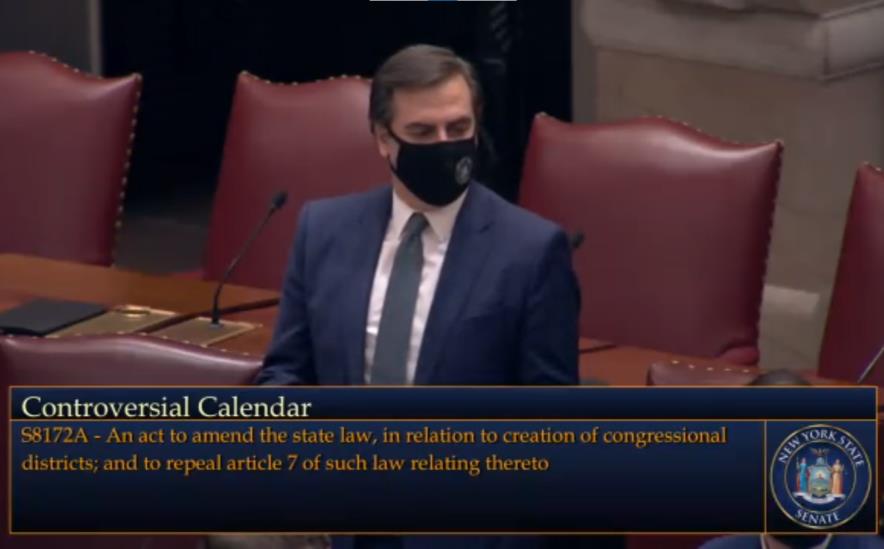
Judge McAllister noted that in some ways the New York Constitution imposes stricter requirements upon Congressional and state legislative districting than do federal standards. Likewise, he noted, state courts hold greater latitude to rule on partisan gerrymandering than do their federal counterparts.
To pass constitutional muster, New York districts, McAllister noted, should, whenever possible, be “contiguous,” “compact,” and “drawn so as not to favor or disfavor an incumbent or a political party.” He found the legislatively-drafted maps of February clearly partisan; drawn so as to likely elect Republicans in as few as four Congressional districts, half the number of Republicans who currently serve New York.
And as for contiguity, McAllister found plenty to complain about as well. He faulted 11 of the State’s 26 new Congressional districts, including Tompkins County’s own new 22nd, as well as its neighbor to the north, the elongated District 24, as failing the “eyeball test.”
“[In some] of these proposed districts you would need a boat to go from one section of the district to the other,” McAllister wrote. Perhaps he was referring to the 22nd’s link to Geneva, accomplished only by sailing Seneca Lake or else by crossing district lines.
Appearing nowhere in the State Supreme Court judge’s holding, however, did McAllister advance an earlier suggestion; namely that candidates run on the Legislature’s currently-enacted maps this one time, but that those elected serve but one year, not two, and run again in 2023.
So the goal for now, barring a successful appeal, remains to get it right this first time; to achieve constitutional conformity before the Primary, whenever it happens to be held. Yet for now, the candidates and their army of volunteers must keep asking this singular question: Are those signed petitions worth more than the paper they’re written on?”
We don’t yet know.
###

